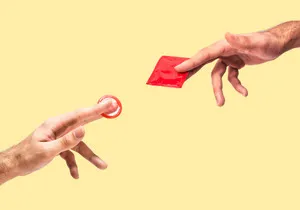A tip, an order: +33 5 63 64 64 46 Mon to Fri from 9h to 17h (normal price call)..|Order tracking|Contact
Condom FAQ

1 - What is a condom?
The condom is a protective layer that the man puts on his penis. Often it is made of rubber or latex. This allows us both to protect ourselves from a possible pregnancy by creating a barrier between the seed and the woman, but also to protect us from a sexually transmitted disease. It is also the only effective method of contraception to stop STDs. This is the reason why it is always recommended to wear a condom when starting a relationship with a new partner. It is good to know that there are also condoms for women.2 - How to find your condom size?
Despite what many of us think, the size of the condom determines the safety and comfort of intercourse. If it is too small, we risk cracking it and thus putting itself in danger. On the contrary, if it is too wide, we can simply lose it. To find out which size is ideal for us, we simply have to measure. Our penis should be measured fully erect. Then measure the thickness, which must be divided by 3.14 to obtain a width. So there is no point in taking the first box from the supermarket or taking the XXL box to flatter our ego.3 - What is the difference between a latex condom and a latex-free one?
Some people have a latex allergy. Whether it is a man or a woman, this criterion must be taken into account when deciding on a choice of condoms. It is quite annoying to experience itching or burning during intercourse because of the latex.To replace latex, manufacturers use polyurethane. According to studies, the latex-free condom tends to crack more easily than latex condoms mainly when unpacking. When we use a polyurethane condom, it is therefore recommended to unroll it carefully and change it if there is any doubt of rupture.
4 - What is the price of a condom?
Condoms are freely available on the Internet, in stores and in pharmacies. No law regulates the price since they are not reimbursed by social security except in certain cases. In general, a condom costs around 56 cents. Female condoms see a price multiply by 4. The price obviously depends on the brand, the size, the number of condoms in the box and the material used for manufacturing. The cost may seem exorbitant because of the low use we make of it. However, be aware that each condom is tested before being sold on the market.5 - Is a condom 100% reliable?
As with all methods of contraception, the condom presents its risk of failure. Traditionally, it is said to be 100% effective, however, in reality, it would be 98% effective. Of course, it must be used correctly, not slip, be the right size and not crack to be able to claim optimal protection. The female condom is 95% effective. If we combine the use of a condom and another form of contraception such as the pill, we are more likely to be protected from pregnancy, but not from STDs.6 - Can we use an expired condom?
Condoms have an expiration date which is often indicated on the individual packaging. If we can’t find the date, throw it out as a precaution. This means that it does not meet European standards or that it has faded due to the weather.Never use an expired condom. Indeed, the latex loses its properties over time. It becomes less resistant and we are more likely to crack the condom in the middle of the act. The lubricant also dries and the report may become less comfortable.





